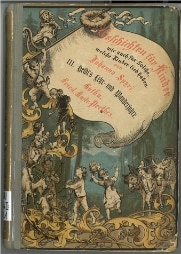Heidi is the most famous Swiss child: she has enchanted generations of children with her love of life. The novel has been translated into over 70 languages and has inspired more than 15 film adaptations. The world fame of "Heidi" began in the United States and spread to Japan. Heidi’s fate also mirrors the story of the 19th-century Swiss emigrants. There are still more unknowns…
Heidi: In the footsteps of a Swiss myth


"Heidi" is the moving story of a little orphaned Swiss girl who finds happiness in her Alpine paradise and touches those around her with her warm heart and cheerfulness. Published in 1880, the first volume of the novel was an immediate hit among readers in Switzerland and Germany. Author Johanna Spyri (1827–1901) published the second volume just a year later.
"Heidi" is not only a masterpiece of Swiss cultural heritage. It is also a global phenomenon. In May 2023, the two Zurich archives of Heidi and Johanna Spyri were added to UNESCO's "Memory of the World" register. UNESCO has thus recognized the exceptional value of these documentary testimonies and paid international tribute to their 140-year history of success and impact.
A story of many Swiss migrants

The novel starts with a sad moment: Aunt Dete brings five-year-old Heidi to her paternal grandfather who lives in seclusion on a mountain pasture above the village of Maienfeld in the canton of Graubünden. Dete leaves the orphan girl with the grumpy old man and hurries away to take up a job as a maid in Frankfurt. Like many Swiss workers and peasants at the time, the aunt emigrated to make a living. In part due to poverty and hunger some 330,000 Swiss emigrated between 1850 and 1888, most headed for the United States.
Heidi’s grandfather, called Alp-Öhi, a Swiss German expression meaning Uncle on the Alp, does not welcome his new charge at first. Heidi soon wins him over with her fearlessness, warm character and interest in nature.
The contrast between the austere mountain life and the urban setting of an emigrant’s daily routine abroad is brought to the reader’s attention when Aunt Dete returns to the mountain pasture and takes Heidi to Frankfurt. There, locked in a mansion of an upper middle-class family, she falls ill. Seeing that she is homesick, the family’s physician insists that she return to her Alpine home.
An international career

“The internationalization of Heidi begins in 1884 in the USA," says the director of the Heidi Archive Peter O. Büttner of the Heidiseum Foundation. Johanna Spyri experienced three different American "Heidi" translations until her death in 1901. By 1936, over 20 million editions had been sold in the USA alone.
Heidi’s first screen appearance was in a silent movie released in the US in 1920. The 1937 Hollywood movie by Allan Dwan, with child star Shirley Temple in the role of Heidi, was the first sound film of Spyri’s novel. This loose adaptation was a box office hit and soon reached European and Asian cinemas. Although the movie was entirely shot in the US, it reinforced the American idea of Switzerland as an Alpine paradise.

In Japan, “Heidi” was highly popular long before the 1937 Hollywood movie. While the novel is first translated into Japanese in 1920, it was a literary adaptation five years later that marked the beginning of a “true passion” for Heidi. In Japan, over 300 translations are known to date.
Heidi’s popularity in Japan may be also linked to the clash between tradition and modernity and to its representation of nature as a source of health, happiness and a manifestation of the sublime. Isao Takahata’s 1974 animated cartoon series Heidi the Girl of the Alps not only marked the height of the Japanese adoration of Heidi, it also made her the heroine of an entire generation of children in Europe.

Takahata, who passed away in April 2018, had travelled to Switzerland to visit the original settings for Spyri’s novel and got his inspiration from the Alpine landscape.
Today, tourists can visit the Japanese Heidi village in Yamanashi Prefecture.
A discreet prominence

Spyri is the most widely read and translated Swiss author, yet little is known about her. She thought it was inappropriate publishing details about herself and ordered that her entire personal estate be destroyed. This may have been because it was frowned for women in high society to expose their lives to public scrutiny, especially as her husband Bernhard Spyri, town clerk of Zurich, held an important political office.
Johanna Spyri grew up in Hirzel, a hillside village not far from Zurich. She moved to the city of Zurich after her marriage, where she led a middle-class life as she wrote "Heidi".
Spyri published some 50 literary works including 32 children’s books – despite having only begun to write at the age of 44.
